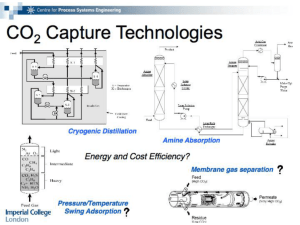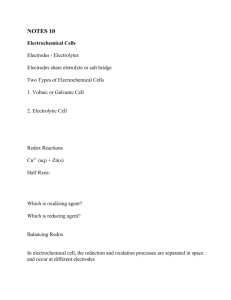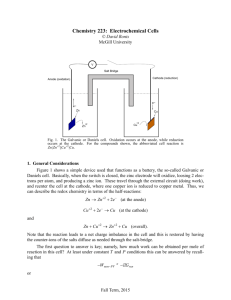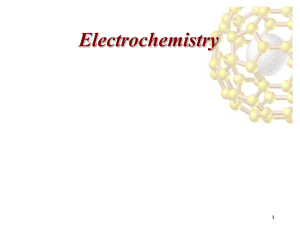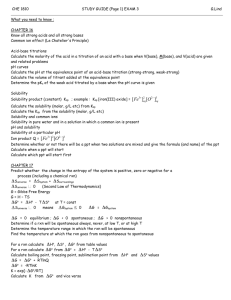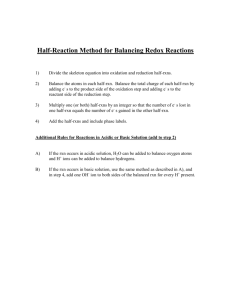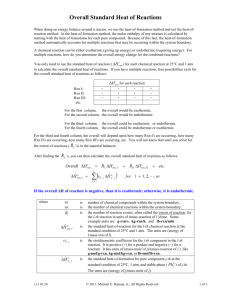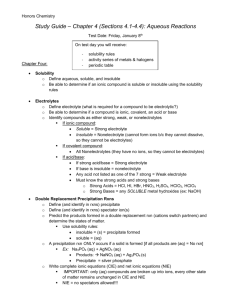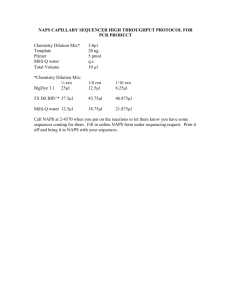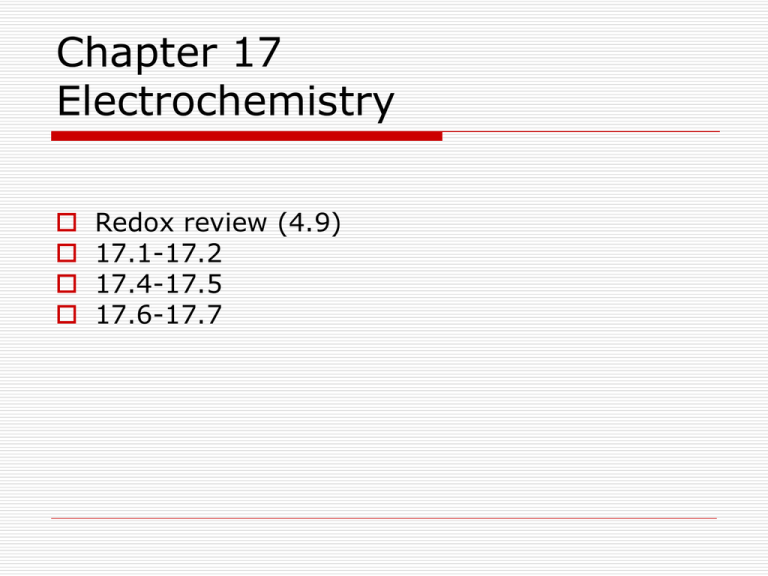
Chapter 17
Electrochemistry
Redox review (4.9)
17.1-17.2
17.4-17.5
17.6-17.7
Review Oxidation-Reduction
Involves transfer of electrons from
reducing agent to oxidizing agent
Oxidation= loss of e (increase in oxid #)
Reduction= gain of e (decrease in oxid#)
GER and LEO
REVIEW
1.
2.
3.
4.
5.
atom in element = 0
monatomic ion = charge
fluorine = -1
oxygen = -2
hydrogen = +1
6. sum of oxid. # in compound = 0
7. sum of oxid. # in polyatomic ion = charge on ion
The Half-Reaction Method (Acidic
Solution)
Copyright © Houghton
Mifflin Company. All
rights reserved.
4–4
Review- Balancing OxidationReduction Reactions
1. Separate in ½ reactions
2. Intermediate steps
a. balance all elements other than H and O
b. balance O with H2O
c. balance H with H+
d. balance charge with (e-)
3. Multiply ½ rxn. so that the number of electrons
is same
4. Add ½ rxns.
Capture the Energy
MnO4- + 5Fe2+ Mn2+ 5Fe3+
MnO4- and Fe2+ will react directly in solution.
Electrons will be transferred and energy
will be released as heat.
No useful work will result.
Capture the Energy!
Zn + Cu2+
-
Zn2+ + Cu
Separate ½ reactions
Connect metals w/ wire
electrons)
(to transfer
Connect soln w/ bridge
(keeps solns separate but allows ions to move)
Converts Chemical Energy to
Electrical Energy!!- A Battery!!
Galvanic Cell
Capture the energy
You have separated the oxidizing
agent from the reducing agent
Requires electron transfer through
wire
Attach a motor, light bulb, bell etcthe current produced in the wire by eflow provides work!!
Figure 17.6 A Galvanic Cell
involving the Half-Reactions
Copyright © Houghton
Mifflin Company. All
rights reserved.
17–10
Cell potential is…..
The pressure of a Galvanic cell to
“push” the e- “driving force”
Electromotive Force, emf
Symbol E
Units: Joule/coulomb (=1Volt, V)
Coulomb = unit of charge
Specifies # of e-
E
cell
=E
anode
+E
cathode
(oxidation)
pushing e-
(reduction)
pulling e-
(black wire)
(red wire)
A spontaneous rxn in a Galvanic cell must
be positive.
E>0
E
1/2
reactions
P. 796 table
Standard Reduction potentials
1M solutions
1atm gases
25 C
Hydrogen ½ rxn = 0.00V
Table 17.1 Standard
Reduction Potentials at
25°C (298K) for Many
Common Half-Reactions
Copyright © Houghton Mifflin
Company. All rights reserved.
17–14
Helpful Info
Need balanced oxidation-reduction rxns from
the reduction potentials.
One reduction ½ rxn must be reversed.
* The ½ rxn with largest positive potential will
run as written (reduction).
The other ½ rxn will run in reverse
(oxidation).
Reversing Direction Changes Sign of E
Because:
E oxidation = -E
Then:
E cell = E
reduction
cathode
Examples:
–E
anode
Standard Reduction Potential
Math Rules
# of e- lost must equal # e- gained
½ rxns must be multiplied by integers to
balance equations
Value of E is not changed when ½ rxn
multiplied by an integer.
Potential is NOT multiplied by integer.
Example….
Line Notation
Anode listed on left
Cathode listed on right
Mg(s) l Mg2+ ll Al3+l Al(s)
Anode Mg0(s) - Mg2+
Cathode Al3+ - Al0(s)
Cell Potential & Free Energy
A galvanic cell will run in the direction
that gives a positive value for E
+E corresponds to - G
+E and - G indicates a spontaneous reaction.
G = -n FE
G = nFE
n = # of e(exchanged in overall rxn)
F = 96,485(c/mol e-)
(Faraday’s constant)
Examples:
Effects of Concentration on E
So far the cells have been under
standard conditions….
Le Chatelier’s principle applies if not std.
conditions..
Determine if E cell > or < E cell ??
To summarize:
If E cell not at standard conditions:
[Reactant] > 1mol/L
E cell > E *cell
[Product] < 1mol/L
E cell> E *cell
Reverse is also true
Concentration cell
Same components in cells, but different
concentrations.
Equilibrium wants these concentrations
to be Equal.
Examples:
Nernst Equation
Establishes relationship b/t cell
potential and concentration of cell
components.
For cells not at 1M Concentration:
E = E * - RT/nF ln (Q)
E * is std cell potential
RT/nF ln (Q) is correction factor
Common form:
E = E * - RT/nF ln (Q)
Commonly written :
E = E * - 0.0591/n log (Q)
Examples:
A Battery @ Equilibrium
At Equilibrium:
Ecell = 0 (completely discharged)
Q=K
and delta G = 0
Using the Nernst Equation:
@Equilibrium: 0 =E * - 0.0591/n log(K)
Or log K = nE */0.0591
Corrosion
Process of returning metals to their
natural state.
Metals oxidize readily resulting in corrosion.
Metal ½ rxn is reversed for oxidation.
Combined with Oxygen ½ rxn. to give (+) Ecell
Electrolysis
Involves forcing current through a cell
to produce a chemical change
resulting in (-) cell potential.
Example:
Figure 17.19 a-b (a) A Standard Galvanic Cell Based on the
Spontaneous Reaction Zn + Cu2+ - Zn2+ + Cu (b) A Standard
Electrolytic Cell. A Power Source Forces the Opposite Reaction
Cu + Zn2+ - Cu2+ + Zn.
Copyright © Houghton
Mifflin Company. All
rights reserved.
17–29

